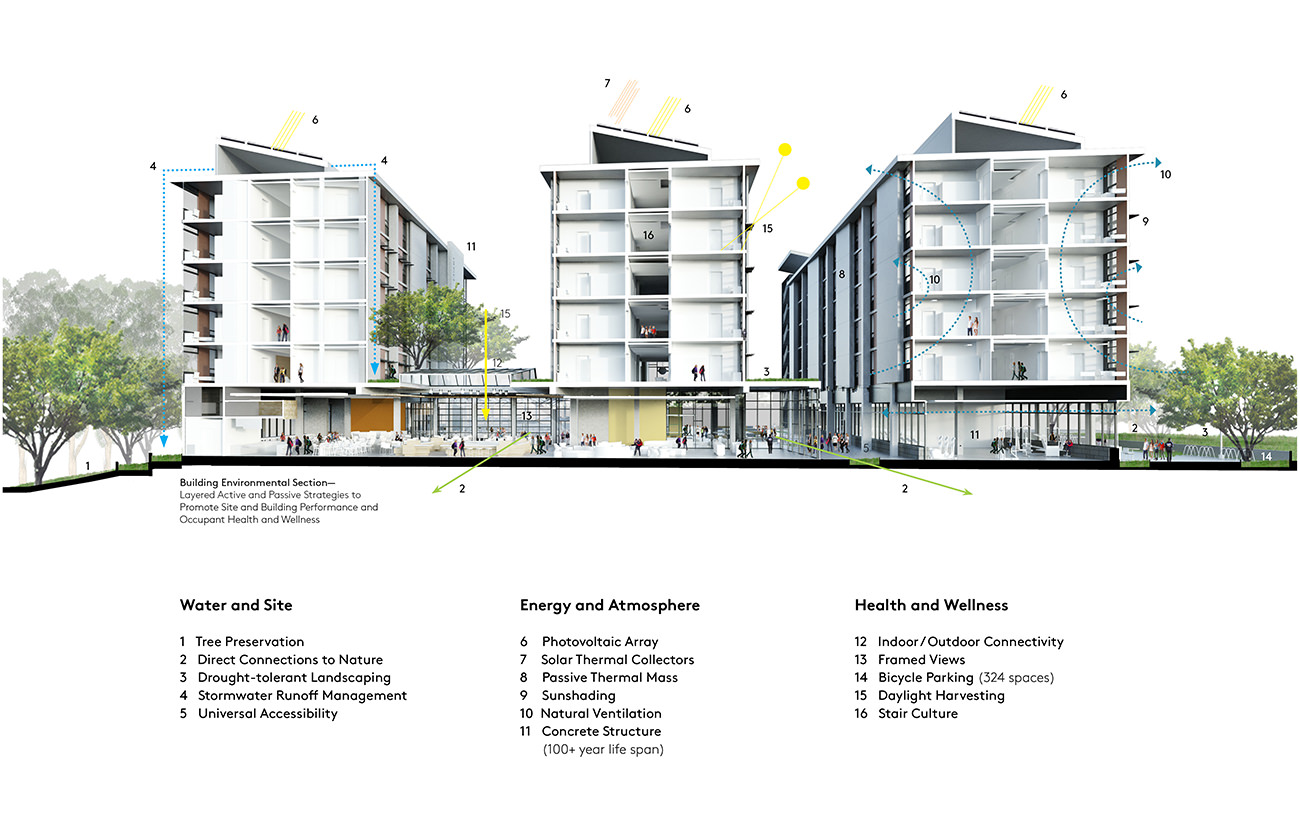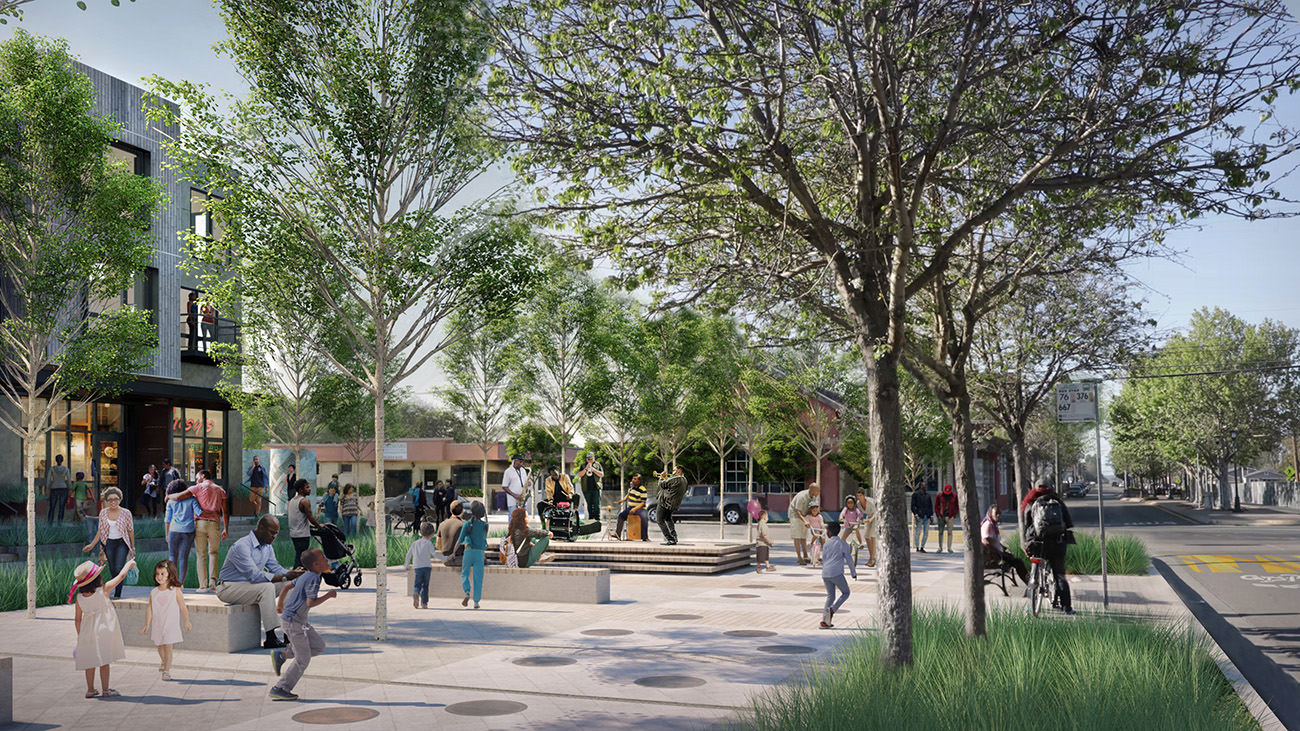Date Posted: 04.19.2021
WHAT DOES DESIGN HAVE TO DO WITH HUMAN HEALTH?
Doctors’ visits and health care are important to address health issues, yet the places we live, work, play, learn and worship play a significant role and shape our everyday behaviors. The social determinants of health model recognizes that these ‘upstream’ factors in our built environment and institutions play a significant role in keeping us healthy. Together, these non-clinical factors represent a whopping 50-70% of what determines our length and quality of life. And that is where design comes in.
Mithun’s Design for Health Initiative has combined practice and research to accelerate design’s capacity to promote well-being. It began when Mithun collaborated with public health consultants on the Mariposa Redevelopment Master Plan, launching one of the first Health Impact Assessments in North America to be integrated directly into a design and development process. Mariposa brought individual health-promoting strategies to scale with a holistic design and programs including healthy housing, food access, social connections, physical activity and lifelong education.
The Design for Health Initiative puts health research and methods to work, explores the evolving relationship between spaces and well-being, and amplifies people-driven strategies as part of integrated design. Its unique approach is shaped by three cornerstones that guide our work:
Evidence based. Our work is built on the foundation of scientific evidence and robust studies. We prioritize evidence-based strategies and collaborate with public health experts to conduct project-specific literature reviews.
People driven. Combining lived experience with health data is fundamental to the Design for Health approach. To better understand how space affects experience, we engage with people who interface with our projects through a range of qualitative and quantitative methods. This data is disaggregated to acknowledge differences in experience based on the varied dimensions of identity, as well as how they may intersect. We pay special attention to inclusion and reducing health inequities through design.
Integrated response. Projects can be most transformational when we understand opportunities to improve well-being upfront, and they can drive an integrated design response. Combining design of the physical ‘hardware’ with ongoing programs or ‘software’ multiplies their potency. From market differentiation, to design for spatial equity, to purchasing policies—health can be promoted throughout the project lifespan.
PIVOTAL MOMENTS IN PRACTICE
Even before the Design for Health Initiative launched, Mithun saw the dramatic results of designing with a specific outcome in mind. Responding to an idea from residents who were experiencing high asthma rates, the Breathe Easy Homes pilot homes at High Point were designed with specific asthmagen-reducing strategies advised by public health and American Lung Association partners. After moving in and with support from community health programs, a study on clinical outcomes found that families had reduced their emergency room visits by 67%.
Inspired by the potential for positive change, Mithun continues to advance research, practice within our projects, and contribute thought leadership to our industry. The Urban Land Institute’s (ULI) Build Healthy Places initiative has spearheaded research and advanced real estate development practice. As a long-time champion, Mithun has contributed to publications including Ten Principles for Building Healthy Places and The Business Case for Healthy Places, and our staff have served as advisors for ULI’s Health Leaders Network.
Within the green building and sustainability world, we collaborated with the Green Health Partnership to influence and test a range of certifications, including the LEED Integrative Process for Health Promotion pilot credit and the Enterprise Green Communities Health Action Plan criterion. Maceo May Apartments, transitional housing for veterans and their families in San Francisco, is an exemplary project combining health, resilience, and trauma-informed design that was recently featured as a ULI Developing Urban Resilience case study.
Mithun’s Design Analytics practice expanded with a specific set of tools to understand the relationships between health, inclusion and design. The Booster Pack: Holistic Design Analytics R+D project, in collaboration with the University of Washington’s Northwest Center for Public Health Practice, developed and tested these tools across project types and scales. With their broad applicability and significant potential to shape project outcomes, we continue to actively deploy these today.
Since the High Point Breathe Easy pilot, healthy material selection has been core to our Design for Health approach and industry advocacy. In 2018, we piloted the HomeFree program with partner Healthy Building Network in our Liberty Bank Building project to select healthier products that people come into contact with most often. This unique, science-based approach identifies a range of better choices with multi-hazard assessments that evaluate the combined risks of all of the components within a product, rather than the presence of specific chemicals. Inspired by this experience, our client Community Roots Housing created a Healthy Homes Initiative.
In 2020, we launched the Centering Health Equity R+D project with the Green Health Partnership to better understand how decisions within real estate and infrastructure delivery can influence health equity. By engaging with practitioners across built environment fields, studying economic forces, and diving deep into real case studies, the project resulted in a beta action framework for practitioners to use in their everyday projects.

TOP DESIGN STRATEGIES FOR HEALTH AND WELL-BEING
To address some of our most prevalent and preventable health issues in North America, Mithun is helping public, private, institutional and non-profit clients leverage design strategies to respond to specific needs and opportunities for all people who interface with our projects. Below are a few that have been most implemented and requested over the last decade.
Biophilia. Humans have an innate connection to nature. Through biophilic design, we can support that connection, and realize cognitive function, physical health and psychological well-being benefits. With big moves and design details, projects like 200 Occidental explore visual, material and sensory connections to nature. Many of these principles are illustrated in the seminal “Biophilic Design: The Theory, Science, and Practice of Bringing Buildings to Life” by Stephen Kellert, Judith Heerwagen, and Martin Modor, with a contributing chapter by Mithun’s Bert Gregory.
Everyday movement. Because many people spend 90% of their time indoors, convenient and everyday ways to get our bodies moving are essential. Whether with active stairs, walking paths, or integrating play, opportunities abound through innovative design. Learning environments like Blakely Elementary School are important places to support cognitive and physical health with movement. Providing choices and fluid indoor-outdoor spaces makes all the difference in motivating us to move. Agile grouping options with furniture and plentiful daylight and fresh air add dynamism to indoor spaces. Nature-inspired recreation and all ages play spaces create accessible ways across generations to incorporate everyday movement.
Social Inclusion. Humans are social creatures. Design can promote connections, mental health and well-being through programming, inclusive spaces and design details. Creative workplace design draws on a robust range of proven strategies to promote connections and elements of joy—from open, communicating stairs to clustered amenity and lounge spaces, to the materiality and patterns that shape a sense of place. Art provides an important way for people to feel connected, and studies show it can reduce stress, improve mood and decrease blood pressure. When we feel safe and welcomed, we can be our best selves.

LOOKING FORWARD TO THE NEXT DECADE
Owners and developers have a tremendous opportunity to advance health and well-being through their projects. Over the past year, our communities and businesses have withstood the COVID-19 pandemic, a significant increase in public realm violence, and increasing climate impacts. As we consider how we might build back better, we believe that centering health equity can improve our collective resilience and ability to thrive. A Design for Health approach can accelerate positive change for the next generation of projects, families, and communities.